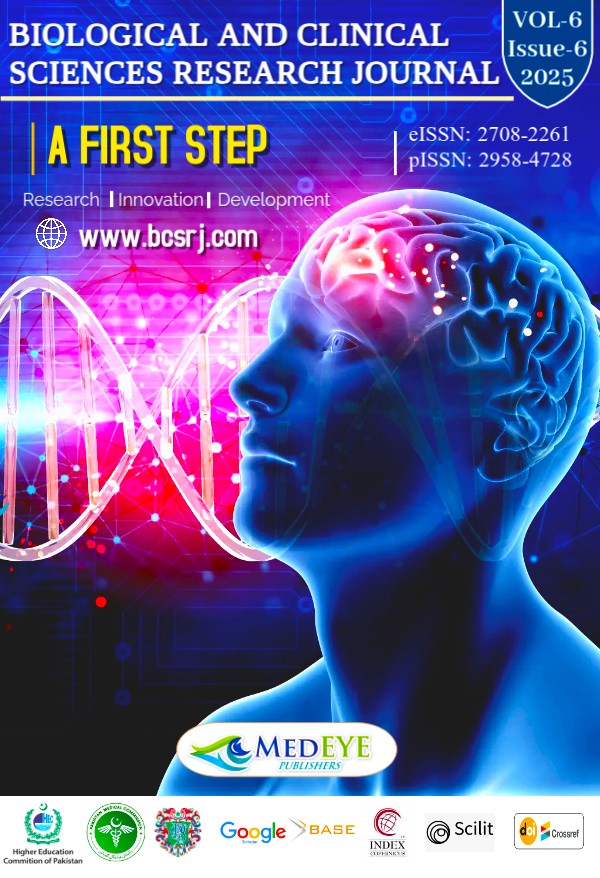Diagnostic Accuracy of MRI in Rotator Cuff Tears
DOI:
https://doi.org/10.54112/bcsrj.v6i6.1971Keywords:
MRI; Rotator cuff tears; Arthroscopy; Diagnostic accuracy; Sensitivity; Specificity; Partial-thickness tear; Full-thickness tear; Supraspinatus; ROC curve (AUC)Abstract
Rotator cuff tears are a common cause of shoulder pain and disability. MRI is widely used for diagnosis, but performance varies by tear type and tendon involved. Objective: To evaluate the diagnostic accuracy of conventional MRI for detecting rotator cuff tears using arthroscopy as the reference standard. Methods: An observational cohort study was conducted from June 2024 to December 2024. Adults with clinically suspected rotator cuff pathology underwent standardized shoulder MRI followed by arthroscopy within the study window. Consecutive sampling yielded 58 participants (mean age 52.79 ± 9.37 years; symptom duration 7.4 ± 4.93 months; 55.2% male). MRI reports documented the presence/absence of a tear, its thickness (partial vs. full), size category, and tendon involvement; intraoperative findings served as the Gold standard. Diagnostic metrics (sensitivity, specificity, PPV, NPV, accuracy) were calculated from 2×2 tables. ROC analysis assessed overall discrimination. Results: MRI identified a tear in 26/58 shoulders (44.8%); arthroscopy confirmed tears in 25/58 (43.1%). The diagnostic contingency table yielded 18 true positives, eight false positives, 25 true negatives, and seven false negatives. Corresponding performance metrics were: sensitivity 72.0%, specificity 75.8%, PPV 69.2%, NPV 78.1%, and accuracy 74.1%. ROC analysis showed fair discrimination (AUC 0.739; p < 0.002). Among MRI-positive cases, 57.7% were partial-thickness and 42.3% full-thickness; the supraspinatus was most frequently involved. Conclusion: Conventional MRI demonstrated moderate accuracy in detecting rotator cuff tears compared to arthroscopy, with performance influenced by the higher proportion of partial-thickness disease. These findings support MRI as a reliable first-line test, while highlighting potential gains from optimized 3-T protocols, selective MR arthrography in cases of equivocal partial tears, and targeted ultrasound for subscapularis-predominant pathology. Further, larger, standardized prospective studies are warranted to refine estimates and guide imaging pathways.
Downloads
References
de Jesus JO, Parker L, Frangos AJ, Nazarian LN. Accuracy of MRI, MR arthrography, and ultrasound in the Diagnosis of rotator cuff tears: a meta-analysis. AJR Am J Roentgenol. 2009;192(6):1701–7. https://doi.org/10.2214/AJR.08.1241
Lenza M, Buchbinder R, Takwoingi Y, Johnston RV, Hanchard NCA, Faloppa F. MRI, MR arthrography and ultrasonography for assessing rotator cuff tears. Cochrane Database Syst Rev. 2013;2013(9):CD009020. https://doi.org/10.1002/14651858.CD009020.pub2
Roy JS, Braën C, Leblond J, Desmeules F, Dionne CE, MacDermid JC, et al. Diagnostic accuracy of ultrasonography, MRI, and MR arthrography for full-thickness rotator cuff tears: a systematic review and meta-analysis. Br J Sports Med. 2015;49(20):1316–28. https://doi.org/10.1136/bjsports-2014-094148
Sharma G, Bhandary S, Khandige G, Kabra U. MR imaging of rotator cuff tears: correlation with arthroscopy. J Clin Diagn Res. 2017;11(5):TC24–7. https://doi.org/10.7860/JCDR/2017/27714.9911
Ooi MWX, Fenning L, Dhir V, Basu S. Rotator cuff assessment on imaging. J Clin Orthop Trauma. 2021;18:121–35. https://doi.org/10.1016/j.jcot.2021.04.004
Florkow MC, Willemsen K, Mascarenhas VV, et al. MRI versus CT for 3D bone imaging in musculoskeletal pathologies: a review. J Magn Reson Imaging. 2022;56(1):11–34. https://doi.org/10.1002/jmri.28067
Smith TO, Back T, Toms AP, Hing CB. The diagnostic accuracy of MRI for the detection of partial- and full-thickness rotator cuff tears in adults. Magn Reson Imaging. 2012;30(3):336–46. https://doi.org/10.1016/j.mri.2011.12.008
Huang T, Wang Z, Xiao J, Chen B, Tan J, Li Z, et al. Diagnostic accuracy of MR arthrography and MRI for bursal-sided partial-thickness rotator cuff tears: a meta-analysis. J Orthop Surg Res. 2019;14:436. https://doi.org/10.1186/s13018-019-1460-y
Madhavi P, Patil P. Diagnostic accuracy of USG and MRI for the detection of rotator cuff injury. Cureus. 2024;16(8):e68199. https://doi.org/10.7759/cureus.68199
Yubran AP, Pesquera LC, Juan ELS, Morales JA, Samaniego LB, et al. Rotator cuff tear patterns: MRI appearance and its surgical relevance. Insights Imaging. 2024;15:61. https://doi.org/10.1186/s13244-024-01607-w
Quinn SF, Sheley RC, Demlow TA, Szumowski J. Rotator cuff tendon tears: evaluation with fat-suppressed MR imaging. Radiology. 1995;195(2):497–502. https://doi.org/10.1148/radiology.195.2.7724768
Teefey SA, Rubin DA, Middleton WD, Hildebolt CF, Leibold RA, Yamaguchi K. Detection and quantification of rotator cuff tears: ultrasonography, magnetic resonance imaging, and arthroscopy in 71 consecutive cases. J Bone Joint Surg Am. 2004;86(4):708–16. https://doi.org/10.2106/00004623-200404000-00007
McGarvey C, Harb Z, Smith C, O'Connor P, Sivarajah R, Compson J. Diagnosis of rotator cuff tears using 3-T MRI versus 3-T MR arthrography: a systematic review and meta-analysis. Skeletal Radiol. 2016;45(2):251–61. https://doi.org/10.1007/s00256-015-2308-1
Lee JH, Yoon YC, Jee S, Koo JY, Choi YJ, Choi SH. Diagnostic performance of three-dimensional isotropic MR arthrography versus conventional two-dimensional indirect MR arthrography for rotator cuff tears. Korean J Radiol. 2014;15(6):771–81. https://doi.org/10.3348/kjr.2014.15.6.771
Liu F, Cheng X, Dong J, Zhou D, Han S, Yang Y. Comparison of MRI and MRA for the Diagnosis of Rotator Cuff Tears: a meta-analysis. Medicine (Baltimore). 2020;99(12):e19579. https://doi.org/10.1097/MD.0000000000019579
Liu F, Dong J, Wang D, Xiong F, Kang Q, Zhou D. Detecting rotator cuff tears: a network meta-analysis of ultrasound, MRI, and MR arthrography. Orthop J Sports Med. 2020;8(1):2325967119900356. https://doi.org/10.1177/2325967119900356
Malavolta EA, Assunção JH, Gracitelli MEC, Alvarenga DM, de Camargo OP, Ferreira Neto AA. Accuracy of magnetic resonance imaging for the Diagnosis of subscapularis tendon tears: a systematic review and meta-analysis. Arch Orthop Trauma Surg. 2019;139(5):659–67. https://doi.org/10.1007/s00402-018-3095-6
Zhu S, Pu D, Li J, Wu D, Huang W, Hu N, et al. Ultrasonography outperforms magnetic resonance imaging in diagnosing partial-thickness tears of the subscapularis muscle. Arthroscopy. 2022;38(2):278–84. https://doi.org/10.1016/j.arthro.2021.07.015
Downloads
Published
How to Cite
Issue
Section
License
Copyright (c) 2025 . Varsha, Piriha Nisar, Abdul Samad, Shaista Shoukat, Sumera Shahbaz, . Sanjana

This work is licensed under a Creative Commons Attribution-NonCommercial 4.0 International License.








